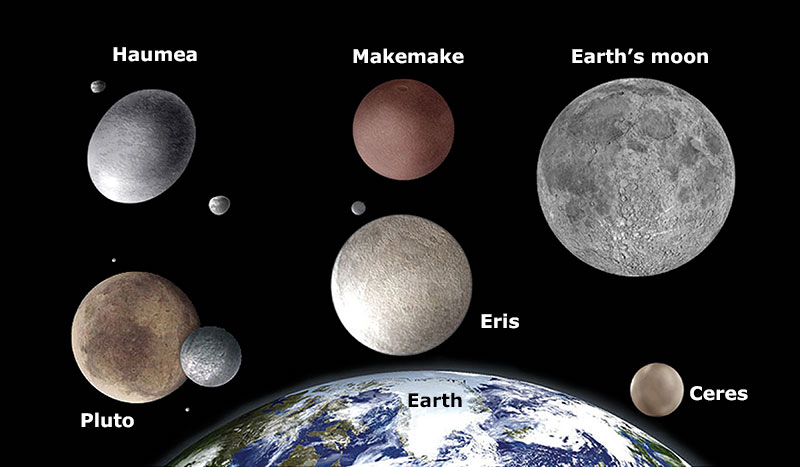Haumea << how MAY ah >> is a dwarf planet in our solar system. A dwarf planet is an object orbiting the sun that is smaller than a planet but larger than a comet or asteroid. Haumea orbits in the Kuiper belt. The Kuiper belt is a region beyond the orbit of Neptune where many icy bodies are found. Haumea has an oblong shape, somewhat like an American football or rugby ball.

Haumea spins once about its axis every 4 hours, making it one of the fastest-spinning large objects in the solar system. Its rapid rotation has caused it to bulge out along its equator. Haumea’s longest diameter, at its equator, is about 1,443 miles (2,322 kilometers). Its shortest diameter, through its axis, is 707 miles (1,138 kilometers). Haumea orbits at an average distance of 4 billion miles (6.5 billion kilometers) from the sun. One complete orbit takes about 285 Earth years. Because of its distance from the sun, Haumea has extremely low surface temperatures, around 50 K (–223 °C or –369 °F).
Haumea formed with the rest of the solar system, about 4.5 billion years ago. Early in the solar system’s history, a large planetesimal likely collided with Haumea at a shallow angle, causing it to spin rapidly. Planetesimals are chunks of rock and ice left over from the formation of the sun and planets. Astronomers have discovered smaller objects in the Kuiper belt with orbits similar to that of Haumea. These objects may represent debris from the collision.
Haumea’s discovery was claimed by two competing teams of scientists and announced in 2005. The dwarf planet was named for the goddess of childbirth and fertility in the mythology of the Polynesian settlers of Hawaii. Also in 2005, astronomers discovered two moons orbiting Haumea. The moons are named Namaka << nah MAH kah >> and Hi’iaka << `hee` ee AH kuh >> for the daughters of Haumea.
On Jan. 21, 2017, Haumea passed in front of a distant star, partly blocking the star’s light. Astronomers were able to make a number of discoveries about the dwarf planet by observing this event. They detected a faint ring of particles orbiting Haumea. It is the only dwarf planet known to have such a ring. Astronomers also determined that Haumea lacks an atmosphere similar to that found on Pluto and may have no atmosphere at all.
